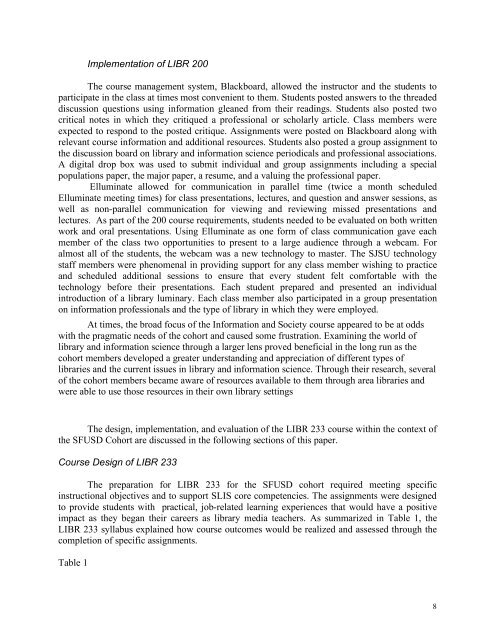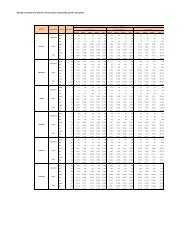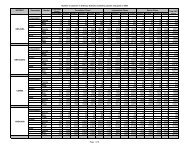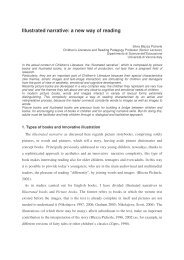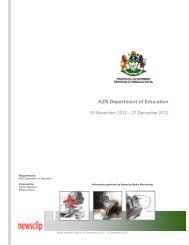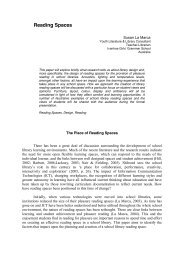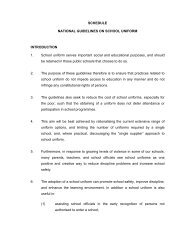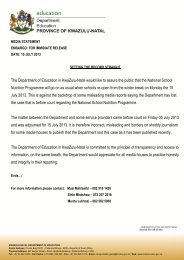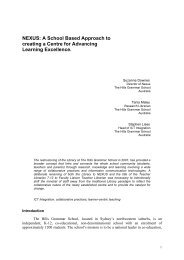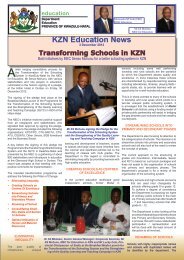Using Technology to Prepare World Class School Librarians to ...
Using Technology to Prepare World Class School Librarians to ...
Using Technology to Prepare World Class School Librarians to ...
Create successful ePaper yourself
Turn your PDF publications into a flip-book with our unique Google optimized e-Paper software.
Implementation of LIBR 200<br />
The course management system, Blackboard, allowed the instruc<strong>to</strong>r and the students <strong>to</strong><br />
participate in the class at times most convenient <strong>to</strong> them. Students posted answers <strong>to</strong> the threaded<br />
discussion questions using information gleaned from their readings. Students also posted two<br />
critical notes in which they critiqued a professional or scholarly article. <strong>Class</strong> members were<br />
expected <strong>to</strong> respond <strong>to</strong> the posted critique. Assignments were posted on Blackboard along with<br />
relevant course information and additional resources. Students also posted a group assignment <strong>to</strong><br />
the discussion board on library and information science periodicals and professional associations.<br />
A digital drop box was used <strong>to</strong> submit individual and group assignments including a special<br />
populations paper, the major paper, a resume, and a valuing the professional paper.<br />
Elluminate allowed for communication in parallel time (twice a month scheduled<br />
Elluminate meeting times) for class presentations, lectures, and question and answer sessions, as<br />
well as non-parallel communication for viewing and reviewing missed presentations and<br />
lectures. As part of the 200 course requirements, students needed <strong>to</strong> be evaluated on both written<br />
work and oral presentations. <strong>Using</strong> Elluminate as one form of class communication gave each<br />
member of the class two opportunities <strong>to</strong> present <strong>to</strong> a large audience through a webcam. For<br />
almost all of the students, the webcam was a new technology <strong>to</strong> master. The SJSU technology<br />
staff members were phenomenal in providing support for any class member wishing <strong>to</strong> practice<br />
and scheduled additional sessions <strong>to</strong> ensure that every student felt comfortable with the<br />
technology before their presentations. Each student prepared and presented an individual<br />
introduction of a library luminary. Each class member also participated in a group presentation<br />
on information professionals and the type of library in which they were employed.<br />
At times, the broad focus of the Information and Society course appeared <strong>to</strong> be at odds<br />
with the pragmatic needs of the cohort and caused some frustration. Examining the world of<br />
library and information science through a larger lens proved beneficial in the long run as the<br />
cohort members developed a greater understanding and appreciation of different types of<br />
libraries and the current issues in library and information science. Through their research, several<br />
of the cohort members became aware of resources available <strong>to</strong> them through area libraries and<br />
were able <strong>to</strong> use those resources in their own library settings<br />
The design, implementation, and evaluation of the LIBR 233 course within the context of<br />
the SFUSD Cohort are discussed in the following sections of this paper.<br />
Course Design of LIBR 233<br />
The preparation for LIBR 233 for the SFUSD cohort required meeting specific<br />
instructional objectives and <strong>to</strong> support SLIS core competencies. The assignments were designed<br />
<strong>to</strong> provide students with practical, job-related learning experiences that would have a positive<br />
impact as they began their careers as library media teachers. As summarized in Table 1, the<br />
LIBR 233 syllabus explained how course outcomes would be realized and assessed through the<br />
completion of specific assignments.<br />
Table 1<br />
8


